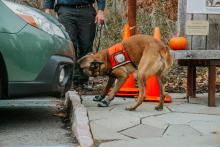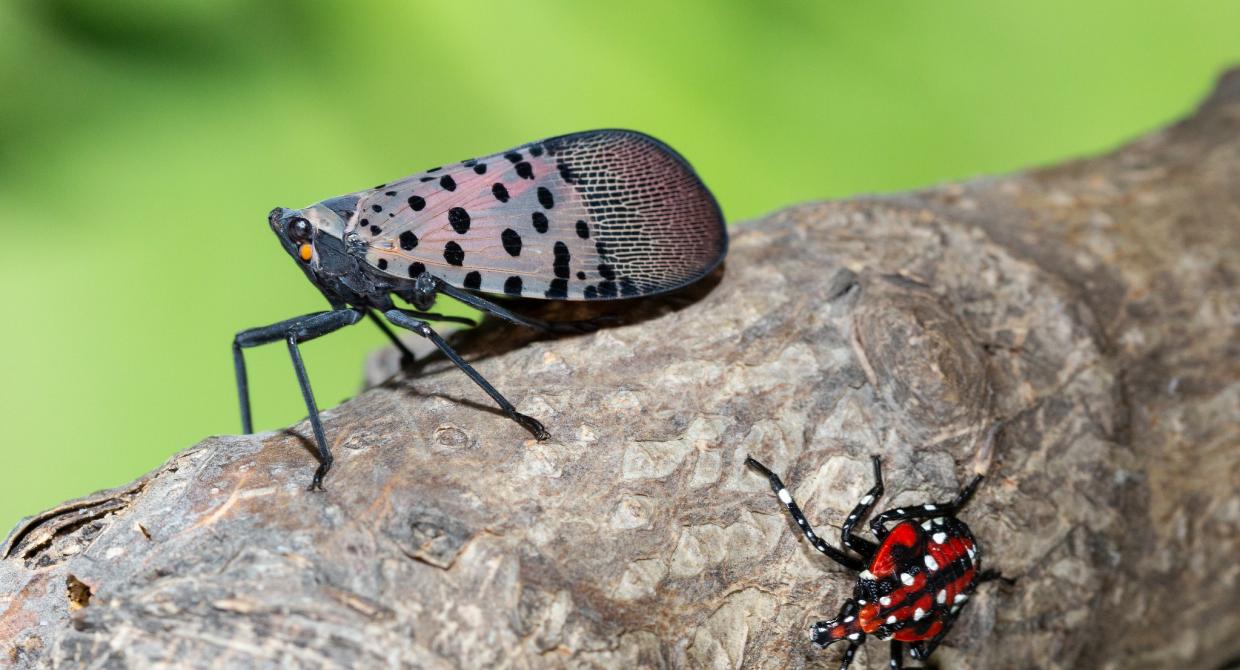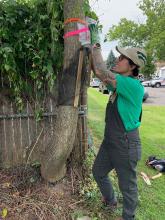
Spotted Lanternfly: Our Response + How You Can Help Fight This Invasive Threat
Title

Body
When there is an urgent threat of invasive species in our region, the Trail Conference’s Ecological Stewardship team springs into action. Our latest target: spotted lanternfly (SLF).
Spotted lanternfly (Lycorma delicatula) is a colorful insect in the planthopper family that congregates in large numbers to feed on the sap of trees. This incredibly destructive pest can feast on over 70 different species of plants, including some of our most iconic native trees and economically important crops such as hops, grapes, and apple trees. Our team has been very busy developing and implementing an SLF early detection and rapid response program in partnership with New York State Department of Agriculture and Markets, the lead agency in stopping SLF in New York. We’ve been targeting SLF infestations in the Lower Hudson Valley region including Orangeburg, Sloatsburg, Port Jervis and Newburgh, N.Y., and calling on our network to respond.
As the leader of the Lower Hudson Partnership for Regional Invasive Species Management (LHPRISM), a partnership of more than 50 organizations, the Trail Conference understands that protecting our region’s natural areas from threats like invasive species requires building a robust network of volunteers, seasonal crews, staff, community organizations, and institutional partnerships that value communication, collaboration, and participation. Building this infrastructure allows us to respond rapidly to new threats—threats that have the potential to destroy the integrity of the ecosystems so vital to our physical and mental wellbeing. This type of cooperative approach to invasive species management has been on full display over the past few months in our battle against spotted lanternfly, an emerging threat to our region’s economy and native habitats.
And what a collaborative effort it has been! Here’s a snapshot of our efforts so far this year.
Spring: Early Detection
This spring, the Ecological Stewardship team recruited volunteers to survey for SLF egg masses, part of a statewide monitoring effort involving the NYS Department of Agriculture and Markets, the NY iMapInvasives database, and the NYS Department of Environmental Conservation. Our program engaged 110 volunteers who dedicated close to 600 hours of surveying for spotted lanternfly egg masses across 197 locations in the Lower Hudson Valley and northern New Jersey. A small group of dedicated volunteers and staff members also teamed with Ag and Markets to remove over 600 SLF egg masses before they could hatch. Each mass contains up to 50 individual eggs, so this urgent effort in the spring helped suppress infestations in advance of full-fledged response efforts this summer.
In tandem with these efforts, our Conservation Dogs team has been invaluable in finding SLF hidden among vegetation. Once a spotted lanternfly report is filed and confirmed by Ag and Markets, we deploy our Conservation Dogs team to assist agency inspectors in further defining the scope of the infestation. These early detection surveys are critical to successfully managing this species before it takes hold in other areas.Summer: Response
Our response plan involves multiple control measures: erecting insect traps on species of trees the SLF is attracted to; clearing vines and other vegetation too small to hold traps; and treating SLF’s host tree, tree-of-heaven (Ailanthus altissima) with insecticide so the insects are killed when they feed. Meanwhile, we encourage swatting, squashing, and stomping as many SLF as possible!
In late July, we brought in our Invasives Strike Force crew to help clear vegetation in preparation for treatments and installation of insect traps. They were joined by staff, other Trail Conference Conservation Corps members, Invasives Strike Force volunteers, PRISM partners, and community partners. This group also helped to remove and dispose of nearly 1,000 individual spotted lanternflies they came across during their brush-clearing work. In addition, they helped facilitate treatments by locating and flagging target host trees. Our Conservation Dogs team was involved in defining the border of currently known infestations so that our treatment plan could move forward with greater accuracy.
In early August, we organized a group of Trail Conference staff, interns, volunteers, and PRISM partners to install nearly 70 insect traps on various host trees and locations, with more traps planned for installation as needs emerge. These traps were purchased and supplied to us by Ag and Markets, who facilitated quick procurement and delivery. Within one week of installation, these traps had already caught over 3,000 SLF, which were promptly removed.In addition, LHPRISM partner Trillium Invasive Species Management performed strategically targeted insecticide treatment of 289 host trees to further curtail the population and prevent spread.
Looking Ahead
This flurry of activity highlights small steps toward our long-term SLF monitoring and management goals, which depend upon public engagement through awareness messaging, detection, and reporting. Another team is ramping up efforts to plan a communication campaign.
With community awareness in mind, the installed traps nearest to public access points feature “Have you see this insect?” signs with species ID and reporting and contact information to help spread public awareness, mitigate tampering, and promote public participation in survey efforts. With the help of citizen science volunteers and LHPRISM staff and partner coordinators, these traps will be checked every 2 weeks through the fall.
This September, the SLF survey program will kick into overdrive as volunteers will help detect SLF adults outside of the known infestation sites.
The synergistic connections between our various programs and sense of shared responsibility for environmental protection, as exemplified in this spotted lanternfly early detection and rapid response model, will continue to drive our Ecological Stewardship Program through 2021 and beyond.
If you are interested in contributing to this effort, there are many ways to help—from donating funds to volunteering time. Volunteers are currently needed to continue vegetation clearing, help with monitoring SLF circle traps and removing caught SLF at these sites, or in surveying for SLF close to your home. Contact Invasives Species Citizen Science Coordinator, Brent Boscarino, at brent@nynjtc.org for more info.
Special thanks to the following participants:
- Catskill Regional Invasive Species Program (CRISP) who cleared vegetation at an infestation site in Huguenot.
- PRISM partners,
- Trillium Invasive Species Management INC donated their time to perform the treatments.
- Suzanne Barclay and Kristen Ossmann, Cornell Cooperative Extension of Rockland County, provided interns to assist with vegetation management and education and outreach to community members.
- Andrew Morgan, Pound Ridge Land Conservancy, brought interns and power tools to help with vegetation clearing in Orangeburg.
- Don Gabel, New York Botanical Garden, advised on treatments, help transport traps to us, and facilitated communication with township employees.
- Glenn Sungela helped with vegetation management.
- Town of Orangetown, Town of Deer Park, and various business owners were very responsive in quickly getting us permission to proceed with treatments and vegetation management.
Thank you to all the private donors who pitched in to fund the purchase of insecticides for the treatments.

